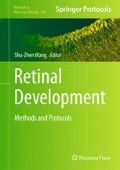Abstract
Retinal regeneration has been studied for decades in nonmammalian species. From these studies, we learned that retinal Müller glia are a potential source of neuronal regeneration by de novo neurogenesis. Although spontaneous regeneration in mammals is absent after retinal damage, we discovered that certain manipulations stimulate a limited regenerative program in adult mice. This allows the study of cellular and molecular barriers that limit regeneration in mice and man as well as to compare it to regenerative species with more complete repair—like fish and birds. Thereby, it may offer novel means to the better understanding of retinal regeneration and develop successful therapies of retinal diseases. In this chapter, we describe the methods to study Müller glia-derived regeneration in adult mice in vivo and discuss potential caveats.
Access this chapter
Tax calculation will be finalised at checkout
Purchases are for personal use only
References
Reh TA, Lamba D, Gust J (2010) Directing human embryonic stem cells to a retinal fate. In: Ding S (ed) Cellular programming and reprogramming methods and protocols. Humana Press, New York
Bartsch U et al (2008) Retinal cells integrate into the outer nuclear layer and differentiate into mature photoreceptors after subretinal transplantation into adult mice. Exp Eye Res 86:691–700
Lamba DA, Gust J, Reh TA (2009) Transplantation of human embryonic stem cell-derived photoreceptors restores some visual function in Crx-deficient mice. Cell Stem Cell 4:73–79
MacLaren RE et al (2006) Retinal repair by transplantation of photoreceptor precursors. Nature 444:203–207
Fischer AJ (2005) Neural regeneration in the chick retina. Prog Retin Eye Res 24:161–182
Hitchcock P et al (2004) Persistent and injury-induced neurogenesis in the vertebrate retina. Prog Retin Eye Res 23:183–194
Raymond PA et al (2006) Molecular characterization of retinal stem cells and their niches in adult zebrafish. BMC Dev Biol 6:36
Senut MC, Fausett B, Veldman M, Goldman D (2007) Gene regulation during axon and tissue regeneration in the retina of zebrafish. In: Becker CG, Becker T (eds) Model organisms in spinal cord regeneration. Wiley-VCH. Hoboken, NJ
Bringmann A et al (2006) Müller cells in the healthy and diseased retina. Prog Retin Eye Res 25:397–424
Garcia M, Vecino E (2003) Role of Müller glia in neuroprotection and regeneration in the retina. Histol Histopathol 18:1205–1218
Pekny M, Nilsson M (2005) Astrocyte activation and reactive gliosis. Glia 50:427–434
Lamba D, Karl M, Reh TA (2008) Neural regeneration and cell replacement: a view from the eye. Cell Stem Cell 2:538–549
Karl MO, Reh TA (2010) Regenerative medicine for retinal diseases: activating endogenous repair mechanisms. Trends Mol Med 16:193–202
Lamba DA et al (2008) Baf60c is a component of the neural progenitor-specific BAF complex in developing retina. Dev Dyn 237:3016–3023
Karl MO et al (2008) Stimulation of neural regeneration in the mouse retina. Proc Natl Acad Sci USA 105:19508–19513
Zhuo L et al (1997) Live astrocytes visualized by green fluorescent protein in transgenic mice. Dev Biol 187:36–42
Basak O, Taylor V (2007) Identification of self-replicating multipotent progenitors in the embryonic nervous system by high Notch activity and Hes5 expression. Eur J Neurosci 25:1006–1022
Nelson BR et al (2011) Genome-wide analysis of Müller glial differentiation reveals a requirement for Notch signaling in postmitotic cells to maintain the glial fate. PLoS One 6:e22817
Yamaguchi M et al (2000) Visualization of neurogenesis in the central nervous system using nestin promoter-GFP transgenic mice. Neuroreport 11:1991–1996
Chattopadhyaya B et al (2004) Experience and activity-dependent maturation of perisomatic GABAergic innervation in primary visual cortex during a postnatal critical period. J Neurosci 24:9598–9611
Dhingra A et al (2008) Probing neurochemical structure and function of retinal ON bipolar cells with a transgenic mouse. J Comp Neurol 510:484–496
Morgan JL et al (2006) Axons and dendrites originate from neuroepithelial-like processes of retinal bipolar cells. Nat Neurosci 9:85–92
Akimoto M et al (2006) Targeting of GFP to newborn rods by Nrl promoter and temporal expression profiling of flow-sorted photoreceptors. Proc Natl Acad Sci USA 103:3890–3895
Feng G et al (2000) Imaging neuronal subsets in transgenic mice expressing multiple spectral variants of GFP. Neuron 28:41–51
Wenzel A et al (2005) Molecular mechanisms of light-induced photoreceptor apoptosis and neuroprotection for retinal degeneration. Prog Retin Eye Res 24:275–306
Joly S et al (2011) Pax6-positive Müller glia cells express cell cycle markers but do not proliferate after photoreceptor injury in the mouse retina. Glia 59:1033–1046
Acknowledgments
We would like to thank the past and present members of the Reh lab for help on paving the way to study retinal regeneration in mice in vivo. This work was supported by grants to MOK (DFG KA 2794/1-1, CRTD, and ProRetina Germany) and TAR (NIH R01 EY 021482).
Author information
Authors and Affiliations
Corresponding author
Editor information
Editors and Affiliations
Rights and permissions
Copyright information
© 2012 Springer Science+Business Media, LLC
About this protocol
Cite this protocol
Karl, M.O., Reh, T.A. (2012). Studying the Generation of Regenerated Retinal Neuron from Müller Glia in the Mouse Eye. In: Wang, SZ. (eds) Retinal Development. Methods in Molecular Biology, vol 884. Humana Press, Totowa, NJ. https://doi.org/10.1007/978-1-61779-848-1_15
Download citation
DOI: https://doi.org/10.1007/978-1-61779-848-1_15
Published:
Publisher Name: Humana Press, Totowa, NJ
Print ISBN: 978-1-61779-847-4
Online ISBN: 978-1-61779-848-1
eBook Packages: Springer Protocols

